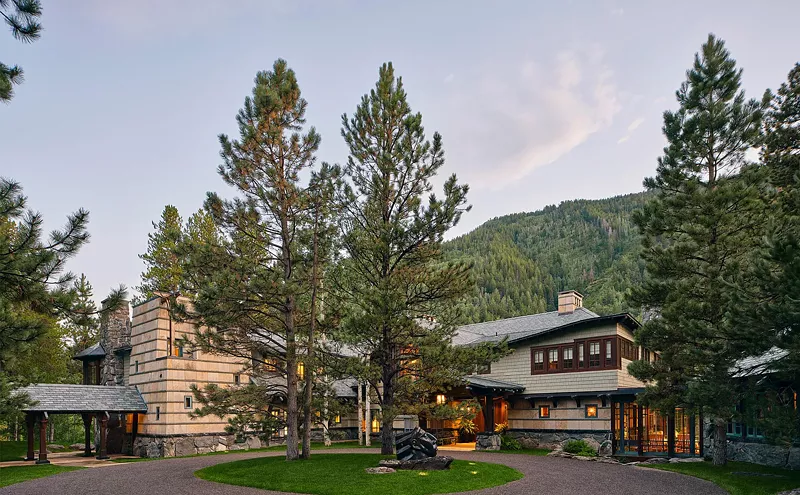At last Thursday's ceremony unveiling Ameristar's big plans, though, you saw mostly garden-variety -- and garden-level -- obstacles. The lofty, 536-room hotel, soon to be one of the largest in Colorado, is still just an empty space over the parking garage. And while the renovation of the several-owners-old casino into an upscale gambling palace is complete, it was closed to cash customers that morning because of a "minor leak." No one was testing the "latest slot product" or tasting the results of "exhibition-style cooking," but the VIP event, with its smattering of Ameristar stars, could not be postponed. Not even after an accident blocked the road up the canyon to Black Hawk, requiring that drivers instead head up I-70 and then across the Central City Parkway through Central City, Black Hawk's onetime nemesis, where the Victorian storefronts are so much more in character with what Coloradans envisioned in 1990 when they approved a constitutional amendment to legalize limited-stakes gaming in the three old mining towns of Cripple Creek, Black Hawk and Central City.
From there, drivers headed down the narrow gulch into Black Hawk, past the reconstituted Mountain City and its handful of old structures relocated from other spots, past what remains of the town's original commercial buildings (of the sixteen surveyed in 1991, eight still stand), out onto Highway 119, where developers literally moved mountains to build their giant casinos, and onto Richman Street (named after the first round of people to strike it rich in the area, back in 1859, when gold was discovered). Pete Meersman, chairman of the Colorado Tourism Board, was on hand to officially welcome Ameristar to the market. State boosters have grown fonder of the gaming industry, since a big funding push in the legislature would use gambling money to increase the state's tourism budget to $20 million. (Perhaps as a thank you, lawmakers exempted casinos from the smoking ban that will hit every bar and restaurant in the state come July 1.)
You can see early results of that push on the Colorado.com website that debuted last week, inexplicably touting this state as "Where Restless Souls Come to Chill Out." Search for Black Hawk, and you land at a picture of the Lace House Museum. Click on History & Heritage, and you get one listing in Black Hawk: the Riviera Casino, which is only six years old.
The Lace House has a hell of a history, but the museum hasn't been open for more than a decade. Not since all the land around the house -- built in 1863 by the man who operated a toll road to the diggings -- was gobbled up by casinos, leaving the Lace House a tiny oasis in a wasteland of impenetrable asphalt. Black Hawk wanted to move the structure to the "historic village" of Mountain City, but in 1997, a Gilpin County judge ruled that the Lace House, the finest example of Carpenter Gothic in the West, should stay right where it was until 2006.
This is the year when Black Hawk's thirty-year contract with the Colorado Historical Society expires.
Back in 1976, Black Hawk must have thought it was getting a pretty sweet deal when the CHS gave the town a $32,000 grant to restore and preserve the Lace House over the next three decades. But that was long before it learned how much casinos would be willing to pour into the town. Eagle Gaming offered $3.5 million just to get the Lace House out of its way. Ameristar has committed $380 million to its Black Hawk project. But then, there's plenty of money to make from gambling, too. In the last fiscal year alone, the state collected more than $100 million in gaming revenues, with $40 million going to the general fund (the pot targeted for tourism's bump) and $26 million going to the historical society, which has handed out more than $177 million in historic-preservation grants since gambling began. By law, the CHS must also give a percentage of its take -- about $5.2 million last year -- to the three gaming towns for more historic-preservation projects.
Which means that Black Hawk, whose population of about a hundred non-restless souls is smaller than the number of people employed by the town, has collected enough cash to fix up the 77 remaining historic residential buildings (down from 105 in 1991) several times over by now. That makes the historical society's original $32,000 deal look downright puny -- just as the Lace House does these days.
With that contract ending, no court will stop Black Hawk from moving the former museum to Mountain City, and even preservationists are ready to surrender to the inevitable. "They've had the site sitting ready for years," says Mark Wolfe, deputy state historic-preservation officer.
"What happened to the Lace House is not a win-win situation for anybody," says Mark Rodman, executive director of Colorado Preservation Inc. "The agreement we've had for the last few years to keep it where it is hasn't really worked."
The Lace House isn't the only place where history is threatened. Back in 1998, Black Hawk itself went on Colorado Preservation's first list of endangered historic sites, and it has not come off. The National Trust for Historic Preservation considers the town one of the nation's eleven most endangered historic places. And the National Park Service has considered booting Black Hawk from its National Historic Landmark District status.
Which is why Black Hawk commissioned Deon Wolfenbarger, a historic-preservation consultant who lives up Highway 119 in Nederland, to survey the district boundaries. Central City, the commercial and cultural center of the gold fields, was granted national landmark status in 1966; in 1991, the district was expanded to include Nevadaville, the original mining town a mile above Central City, and Black Hawk, the original milling town a mile below. "When Black Hawk was listed in '91, many of the buildings were already destroyed," Wolfenbarger notes. "All the old mills were gone. Today, large buildings are where large buildings used to be."
That doesn't mean the casinos are historic, but that perhaps the historic boundaries should be shifted to reflect both the changes in town and all of the historic areas outside the current district lines, including most of the residences and all of the mining structures. "The towns are significant because of the gold that was discovered there, yet they didn't include the mining resources," the consultant says of the 1991 landmark nomination. "They found more gold there than anywhere else. It precipitated the westward movement that leapfrogged across the plains."
Wolfenbarger, whose "timeline is to finish it by this summer," says she plans to recommend that, rather than delist Black Hawk, the National Park Service should consider a survey of what's historic outside of the original district. Wolfenbarger, who's worked for the park service, has already had preliminary discussions with officials there. "I fear that if Black Hawk is gone, they [the service] might remove the rest," she says. "They would not be the only three-town mining group. You have to be exceptional, really singular. A National Historic Landmark is the crme de la crme."
The cream was skimmed off the Lace House a long time ago. The question of moving it is a "double-edged sword for preservationists," Wolfenbarger adds. "You don't want to move it, but it has lost its context. You can't have a historic district if there's just one building floating in a sea of new construction."
Then again, you can still make a historic statement. Rodman thinks that the casino eager to take over the Lace House spot could still incorporate the structure into its expanded parking-lot design, maybe as an office for the valet. At least then, someone would see the inside of the building. "It would be the best of a bad situation," he says.
And a hell of a history lesson.
Unless there's room for the Lace House on top of Ameristar.












